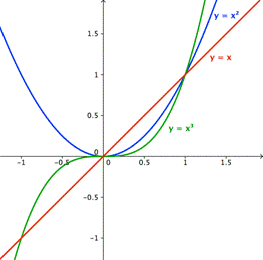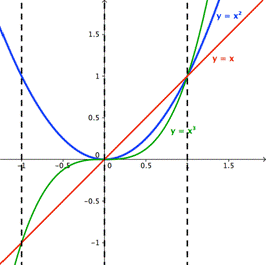Inductive Reasoning
Learning Objective(s)
· Identify and provide examples of inductive reasoning.
Inductive reasoning is a sophisticated mathematical tool, yet we've all been using it since we were babies! When we use inductive reasoning, we use our experiences and observations to draw conclusions about what will happen in the future. The first several times we dropped something as a child, the object fell to the floor. Eventually, we decided this pattern would continue, no matter what the object was: things fall down. Inductive reasoning is a great way to discover new things in mathematics, too. But is it still that simple?
Generalizing and Making Conjectures
We'll start by looking for patterns in a diagram. Let's try to predict what the next three figures will be in this sequence:
![]()
![]()
![]()
![]()
![]()
![]()
![]()
To answer this, we have to take several steps, steps which make up the inductive reasoning process.
1. First, observe the figures, looking for similarities and differences. In the example, there are two colors, red and blue, and they alternate. Also, all of the figures are triangles that appear to be the same size and shape, just turned differently.
2. Next, generalize these observations. When we generalize, we take observations about a few examples and assume that every other example will work the same. In this case, generalizing means we assume that the patterns will continue—for example, that the colors will continue to be red and blue, and that they will continue to alternate.
3. Then, we form a conjecture. A conjecture is an attempt to make a conclusion about examples based on our generalization. Conjectures haven’t been proven to be right or wrong, and as long as we’re not just making a wild guess, all conjectures are worth thinking about. In this example, we can conjecture about the color and orientation of triangles we can't yet see.
4. Finally, in some situations, we can apply your conjecture to make a prediction about the next few figures. We might predict the next triangles will be blue, then red, then blue again. If we did, we'd be right. Here are the next three figures in the pattern:
![]()
![]()
![]()
We use the same steps when finding patterns in a table of data or a sequence, which is an ordered list of objects such as numbers or diagrams. Here's a numerical example:
| Example | |||
| Problem | Write an expression for the nth term in the sequence 3, 5, 7, 9, 11, … and find the value of the 100th term. |
|
|
|
| - The terms are all odd numbers. - Each term is greater than the one before it. - The difference between one term and the next one is 2. |
| First look for similarities and differences between the terms. |
|
| Assume that each term is going to be 2 more than the one before it. (They will all continue to be odd.) |
| Generalize the observations. |
|
| The next terms will be 13, 15, and 17.
Term 1 is 3. Term 2 is 5. Term 3 is 7. Term 4 is 9.
As the term position goes up by 1, the term value goes up by 2.
Try multiplying the term position by 2: Term 1 gives 2. Term 2 gives 4. Term 3 gives 6.
Each of these is too low by 1, so add 1: Term 4 is 2 • 4 + 1 = 9. That worked!
The nth term has value 2n + 1. |
| Write a conjecture. Since the problem asks for the nth term, we want an algebraic expression that connects the position of the term in the sequence to the term’s value. |
|
|
The 100th term has a value of 2(100) + 1, or 201. |
| Make the prediction requested by the problem. (This step may not always be needed.) |
| Answer | The nth term is 2n + 1, and the 100th term is 201. |
|
|
| Consider this sequence of numbers:
100, 97, 94, 91, 88, …
Make a conjecture: What is the 10th term of this sequence? What is the nth term?
|
Testing and Revising Conjectures
An important thing to remember about conjectures is that they may or may not be right. As with any logical statement, take the time to look for counterexamples, and also verify that the examples on which the conjecture was based actually fit it too.
Take a look at this example of a conjecture gone wrong:
Helen evaluated the polynomial n2 + 19n − 19 for several values of n and noticed something about the results:
| N | n2 + 19n − 19 |
| 1 | 1 |
| 2 | 23 |
| 3 | 47 |
| 4 | 73 |
| 5 | 101 |
Except for 1, all the values in the n2 + 19n − 19 column are prime. Helen generalized that this will happen for all values of n from 2 up, and wrote this conjecture: For any whole number n where n ≥ 2, the value n2 + 19n − 19 is prime.
To test her idea, Helen checked another ten whole numbers, from 6 to 15, and the results were all prime! But a friend looked at the equation and said, "You've got 19s in the expression. What if n = 19? Then you have 192 + 19(19) − 19." Can you see that this expression would have a factor of 19? The friend provided a counterexample to Helen's conjecture because when n = 19 the expression has a value of 703, which is not prime because 703 = 19 • 37.
This is one of the disadvantages of inductive reasoning: A conjecture found by inductive reasoning may or may not always be true. This is common when we overgeneralize, that is, when we use a small number of observations and try to apply them to a much wider situation. If all we can do is test individual examples, it's difficult, if not impossible, to say that there may not be a counterexample that we haven't found yet. For example, remember that childhood conjecture that objects will always fall when dropped? What if the object is a balloon filled with helium? Oops.
Finding a counterexample doesn't call for despair—we may be able to use the new information to revise our conjecture.
| Example | ||||||||||||||||||||||||||||
| Problem | Deshawn looked at the x, x2, and x3 values below and decided that x ≤ x2 ≤ x3 for all real numbers. Find counterexamples and refine Deshawn's conjecture.
|
| ||||||||||||||||||||||||||
|
|
|
| The table only includes natural numbers for x, but Deshawn overgeneralized the results to all real numbers. The conjecture is true for some rational numbers (such as x=1.5), but not all of them (such as x = 0.5). It doesn't appear to be true for any negative numbers. | |||||||||||||||||||||||||
|
|
|
| To get a good look at when this inequality is true, graph the functions, y = x (in red), y = x2 (in blue), and y = x3 (in green).
| |||||||||||||||||||||||||
|
|
|
| The inequality says the red should be below both the blue and green, and the blue should be below the green. Find the areas where this is true.
The red is below the blue when x < 0 and x > 1. However, the green is below (or touches) the blue when x < 1. So the only values when x < x2 < x3 are x > 1.
| |||||||||||||||||||||||||
| Answer | Counterexamples: x = 0.5, x = -0.5, and x = -1.
Revised conjecture: x ≤ x2 ≤ x3 for all real numbers of x ≥ 1. |
| Since Deshawn's conjecture included x = x2 = x3, the value x = 1 can be included in the revision. | |||||||||||||||||||||||||
Identifying Inductive Reasoning
Because conjectures based on inductive reasoning may or may not be true, it's important to recognize when inductive reasoning is being used to make a conjecture. Then we can think more about whether the conjecture is reasonable based on the observations, whether the conjecture overgeneralizes those observations, and whether there may be counterexamples that we should look for.
| Example | |||
| Problem | Jeanne's birthday was on a Wednesday one year. She noticed that the next year it would fall on a Thursday, and it would fall on a Friday in two years. Without checking, she said, "My birthday will be on a Wednesday again in seven years."
Is she using inductive reasoning? Why or why not? |
| |
|
| Whether or not Jeanne is using inductive reasoning depends on the process she uses, not whether she is correct or not.
Jeanne has: - Noticed similarities and differences in the day her birthday falls each year. For the three years she observed, she noticed that the day of the week was one later each year. - Generalized her observations, assuming that the pattern would continue. - Formed a conjecture. Although she didn't state it, exactly, her conjecture was: If my birthday is x years after my last birthday, it will fall x days later in the week than my last birthday did. Notice that she even applied the conjecture to make a prediction (though that's not a necessary part of the inductive reasoning process).
|
| |
| Answer | Yes, she used inductive reasoning. She made a conjecture about a longer pattern by generalizing some specific observations.
|
|
|
(By the way, Jeanne's conjecture is incorrect. A leap year occurs every four years and throws the pattern off.)
| When trying to graph y = |-x|, Benny reasoned this way:
Absolute value just makes the value positive or zero. So, the result of |-x| is the positive version of x, or 0 if x = 0. But the result of |x| is also the positive version of x, or 0 if x = 0. That means |-x| = |x|. So the graph of y = |-x| is the same as the graph of y = |x|.
Is Benny using inductive reasoning?
A) No B) Yes
|
Summary
Inductive reasoning is a kind of logical reasoning which involves drawing a general conclusion, called a conjecture, based on a specific set of observations. In this process, specific examples are examined for a pattern, and then the pattern is generalized by assuming it will continue in unseen examples. Conjectures and predictions can then be made. Conjectures may not be true, especially if a pattern has been overgeneralized, that is, applied to a larger set of circumstances than the observations support. If counterexamples to a conjecture are found, it may be possible to revise the conjecture so that it becomes always true.


